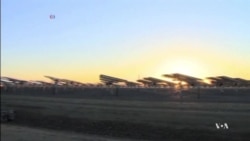By 2018, a large solar power plant in the Tunisian part of the Sahara desert may start sending power to energy-hungry Western Europe. The company running the plant says once it is fully operational it will generate almost twice as much electricity as an average nuclear plant and supply two million homes in Europe.
According to the European Commission’s Institute for Energy, just 0.3 percent of the Saharan Desert's intense solar energy can provide Europe with all the electrical power it needs.
A company called Nur Energy plans to capture some of it by building a solar plant similar to an Israeli one in the Negev desert that uses heliotropic mirrors. This technology, unlike photovoltaic cells, can generate energy even when the sky is overcast or at night.
Thousands of mirrors, spread over 100 square kilometers, will concentrate sunlight to a tower where it heats and melts a special salt.
Kevin Sara, the CEO of Nur Energy, said the technology makes storage easy.
"You can then store that heat very easily, so you can continue producing electricity after the sun goes down,” said Sara.
In a heat exchanger, the molten salt turns water into steam for turbines that turn electrical generators.
Sara said the project could significantly decrease use of fossil fuels in Europe.
"We could gradually decarbonize the European grid using desert power, using this solar energy with storage from the Sahara desert and linked to Europe with high-voltage DC cables which are very, very low in their losses,” said Sara,
The cable link to Europe is another interesting part of the project.
Instead of the usual alternating current transmission, Nur Energy plans to send the power by a dedicated direct current underwater cable. Power being sent through the cable has a loss rate of just 3 percent per 1,000 kilometers. In addition to being cheaper, this technology requires no synchronization between different AC transmission systems.
Recently, Tunisia held its second democratic parliamentary elections. Sara said the solar energy project could contribute to the country’s stability.
"A lot of this equipment can be manufactured by local Tunisian companies, and that will create employment and employment opportunities for the Tunisian youth,” said Sara.
The construction of the solar plant in southwestern Tunisia is expected to start by the end of 2016, with the first kilowatts being delivered by late 2018.







